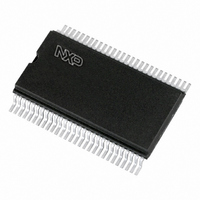TEA6825T/V1,118 NXP Semiconductors, TEA6825T/V1,118 Datasheet - Page 45

TEA6825T/V1,118
Manufacturer Part Number
TEA6825T/V1,118
Description
IC RADIO ICE 56-VSO
Manufacturer
NXP Semiconductors
Datasheet
1.TEA6825TV1118.pdf
(48 pages)
Specifications of TEA6825T/V1,118
Frequency
AM, FM, WB
Modulation Or Protocol
AM, FM
Applications
In Car Entertainment(ICE) Car Radio
Current - Receiving
39mA
Data Interface
PCB, Surface Mount
Antenna Connector
PCB, Surface Mount
Voltage - Supply
4.5 V ~ 5.5 V
Operating Temperature
-40°C ~ 85°C
Package / Case
56-VSOP
Lead Free Status / RoHS Status
Lead free / RoHS Compliant
Features
-
Sensitivity
-
Memory Size
-
Data Rate - Maximum
-
Other names
935243860118
TEA6825TD-T
TEA6825TD-T
TEA6825TD-T
TEA6825TD-T
Philips Semiconductors
SOLDERING
Introduction
There is no soldering method that is ideal for all IC
packages. Wave soldering is often preferred when
through-hole and surface mounted components are mixed
on one printed-circuit board. However, wave soldering is
not always suitable for surface mounted ICs, or for
printed-circuits with high population densities. In these
situations reflow soldering is often used.
This text gives a very brief insight to a complex technology.
A more in-depth account of soldering ICs can be found in
our “Data Handbook IC26; Integrated Circuit Packages”
(order code 9398 652 90011).
Reflow soldering
Reflow soldering techniques are suitable for all VSO
packages.
Reflow soldering requires solder paste (a suspension of
fine solder particles, flux and binding agent) to be applied
to the printed-circuit board by screen printing, stencilling or
pressure-syringe dispensing before package placement.
Several techniques exist for reflowing; for example,
thermal conduction by heated belt. Dwell times vary
between 50 and 300 seconds depending on heating
method. Typical reflow temperatures range from
215 to 250 C.
Preheating is necessary to dry the paste and evaporate
the binding agent. Preheating duration: 45 minutes at
45 C.
1998 Mar 24
In Car Entertainment (ICE) car radio
45
Wave soldering
Wave soldering techniques can be used for all VSO
packages if the following conditions are observed:
During placement and before soldering, the package must
be fixed with a droplet of adhesive. The adhesive can be
applied by screen printing, pin transfer or syringe
dispensing. The package can be soldered after the
adhesive is cured.
Maximum permissible solder temperature is 260 C, and
maximum duration of package immersion in solder is
10 seconds, if cooled to less than 150 C within
6 seconds. Typical dwell time is 4 seconds at 250 C.
A mildly-activated flux will eliminate the need for removal
of corrosive residues in most applications.
Repairing soldered joints
Fix the component by first soldering two diagonally-
opposite end leads. Use only a low voltage soldering iron
(less than 24 V) applied to the flat part of the lead. Contact
time must be limited to 10 seconds at up to 300 C. When
using a dedicated tool, all other leads can be soldered in
one operation within 2 to 5 seconds between
270 and 320 C.
A double-wave (a turbulent wave with high upward
pressure followed by a smooth laminar wave) soldering
technique should be used.
The longitudinal axis of the package footprint must be
parallel to the solder flow.
The package footprint must incorporate solder thieves at
the downstream end.
TEA6823T; TEA6825T
Preliminary specification













